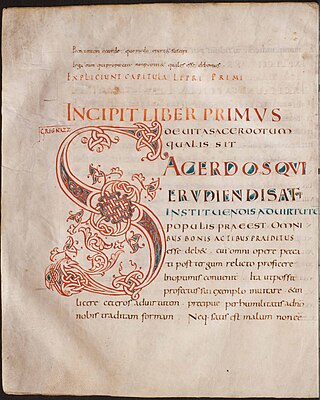The deuterocanonical books are books and passages considered by the Catholic Church, the Eastern Orthodox Church, the Oriental Orthodox Churches, and/or the Assyrian Church of the East to be canonical books of the Old Testament, but which Jews and Protestants regard as apocrypha. They date from 300 BC to 100 AD, before the separation of the Christian church from Judaism. While the New Testament never directly quotes from or names these books, the apostles quoted the Septuagint, which includes them. Some say there is a correspondence of thought, and others see texts from these books being paraphrased, referred, or alluded to many times in the New Testament, depending in large measure on what is counted as a reference.
An ecumenical council, also called general council, is a meeting of bishops and other church authorities to consider and rule on questions of Christian doctrine, administration, discipline, and other matters in which those entitled to vote are convoked from the whole world (oikoumene) and which secures the approbation of the whole Church.

The First Council of Nicaea was a council of Christian bishops convened in the Bithynian city of Nicaea by the Roman Emperor Constantine I in AD 325.

The Second Council of Constantinople is the fifth of the first seven ecumenical councils recognized by both the Eastern Orthodox Church and the Catholic Church. It is also recognized by the Old Catholics and others. Protestant opinions and recognition of it are varied. Some Protestants, such as Calvinists, recognize the first four councils, whereas Lutherans and most Anglo-Catholics accept all seven. Constantinople II was convoked by the Byzantine Emperor Justinian I under the presidency of Patriarch Eutychius of Constantinople. It was held from 5 May to 2 June 553. Participants were overwhelmingly Eastern bishops—only sixteen Western bishops were present, including nine from Illyricum and seven from Africa, but none from Italy—out of the 152 total.

A synod is a council of a Christian denomination, usually convened to decide an issue of doctrine, administration or application. The word synod comes from the Ancient Greek σύνοδος 'assembly, meeting'; the term is analogous with the Latin word concilium'council'. Originally, synods were meetings of bishops, and the word is still used in that sense in Catholicism, Oriental Orthodoxy and Eastern Orthodoxy. In modern usage, the word often refers to the governing body of a particular church, whether its members are meeting or not. It is also sometimes used to refer to a church that is governed by a synod.
The Synod of Ancyra was an ecclesiastical council, or synod, convened in Ancyra, the seat of the Roman administration for the province of Galatia, in 314. The season was soon after Easter; the year may be safely deduced from the fact that the first nine canons are intended to repair havoc wreaked in the church by persecution, which ceased after the overthrow of Maximinus II in 313. Only about a dozen bishops were present, nonetheless representing nearly every part of Syria and Asia Minor. Either Vitalis, Bishop of Antioch, or Marcellus of Ancyra presided, and possibly both were present, although the Libellus Synodicus, also known as the Synodicon Vetus, assigns to the latter.

The Synod of Elvira was an ecclesiastical synod held at Elvira in the Roman province of Hispania Baetica, now Granada in southern Spain. Its date has not been exactly determined but is believed to be in the first quarter of the fourth century, approximately 305–6. It was one of three councils, together with the Synod of Arles (314) and the Synod of Ancyra, that first approached the character of general councils and prepared the way for the first ecumenical council. It was attended by nineteen bishops and twenty-six presbyters, mostly resident in Baetica. Deacons and laymen were also present. Eighty-one canons are recorded, although it is believed that many were added at later dates. All concern order, discipline and conduct among the Christian community. Canon 36, forbidding the use of images in churches, became a bone of contention between Catholic and Protestant scholars after the Protestant Reformation.
The Gelasian Decree is a Latin text traditionally thought to be a Decretal of the prolific Pope Gelasius I, bishop of Rome from 492–496. The work reached its final form in a five-chapter text written by an anonymous scholar between 519 and 553, the second chapter of which is a list of books of Scripture presented as having been made part of the biblical canon by a Council of Rome under Pope Damasus I, the bishop of Rome from 366–383. This list is known as the Damasine List. The fifth chapter of the work includes a list of distrusted and rejected works not encouraged for church use.
Iconodulism designates the religious service to icons. The term comes from Neoclassical Greek εἰκονόδουλος (eikonodoulos), meaning "one who serves images (icons)". It is also referred to as iconophilism designating a positive attitude towards the religious use of icons. In the history of Christianity, iconodulism was manifested as a moderate position, between two extremes: iconoclasm and iconolatry.
A nomocanon is a collection of ecclesiastical law, consisting of the elements from both the civil law and the canon law. Nomocanons form part of the canon law of the Eastern Catholic Churches and of the Eastern Orthodox Church.
Collections of ancient canons contain collected bodies of canon law that originated in various documents, such as papal and synodal decisions, and that can be designated by the generic term of canons.
The Old Testament is the first section of the two-part Christian biblical canon; the second section is the New Testament. The Old Testament includes the books of the Hebrew Bible (Tanakh) or protocanon, and in various Christian denominations also includes deuterocanonical books. Orthodox Christians, Catholics and Protestants use different canons, which differ with respect to the texts that are included in the Old Testament.
In the history of Christianity, the first seven ecumenical councils include the following: the First Council of Nicaea in 325, the First Council of Constantinople in 381, the Council of Ephesus in 431, the Council of Chalcedon in 451, the Second Council of Constantinople in 553, the Third Council of Constantinople from 680–681 and finally, the Second Council of Nicaea in 787. All of the seven councils were convened in what is now the country of Turkey.
A biblical canon is a set of texts which a particular Jewish or Christian religious community regards as part of the Bible.

The Collectio canonum quadripartita is an early medieval canon law collection, written around the year 850 in the ecclesiastical province of Reims. It consists of four books. The Quadripartita is an episcopal manual of canon and penitential law. It was a popular source for knowledge of penitential and canon law in France, England and Italy in the ninth and tenth centuries, notably influencing Regino's enormously important Libri duo de synodalibus causis. Even well into the thirteenth century the Quadripartita was being copied by scribes and quoted by canonists who were compiling their own collections of canon law.
Jus antiquum is a period in the legal history of the Catholic Church, spanning from the beginning of the church to the Decretum of Gratian, i.e. from A.D. 33 to around 1150. In the first 10 centuries of the church, there was a great proliferation of canonical collections, mostly assembled by private individuals and not by church authority as such.
The Catholic Church utilizes the oldest continuously functioning legal system in the West, much later than Roman law but predating the evolution of modern European civil law traditions. The history of Latin canon law can be divided into four periods: the jus antiquum, the jus novum, the jus novissimum and the Code of Canon Law. In relation to the Code, history can be divided into the jus vetus and the jus novum. Eastern canon law developed separately.

The Paenitentiale Theodori is an early medieval penitential handbook based on the judgements of Archbishop Theodore of Canterbury. It exists in multiple versions, the fullest and historically most important of which is the U or Discipulus Umbrensium version, composed (probably) in Northumbria within approximately a decade or two after Theodore's death. Other early though far less popular versions are those known today as the Capitula Dacheriana, the Canones Gregorii, the Canones Basilienses, and the Canones Cottoniani, all of which were compiled before the Paenitentiale Umbrense probably in either Ireland and/or England during or shortly after Theodore's lifetime.

The Collectio canonum Quesnelliana is a vast collection of canonical and doctrinal documents prepared (probably) in Rome sometime between 494 and (probably) 610. It was first identified by Pierre Pithou and first edited by Pasquier Quesnel in 1675, whence it takes its modern name. The standard edition used today is that prepared by Girolamo and Pietro Ballerini in 1757.

The Collectiones canonum Dionysianae, also known as Collectio Dionysiana or Dionysiana Collectio, are the several collections of ancient canons prepared by a Scythian monk, Dionysius 'the humble' (exiguus). They include the Collectio conciliorum Dionysiana I, the Collectio conciliorum Dionysiana II, and the Collectio decretalium Dionysiana. They are of the utmost importance for the development of the canon law tradition in the West.